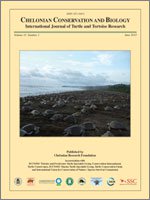The dash of freshly emerged hatchlings to the sea is a short but critical phase in the life cycle of sea turtles. We examine the time spent on a Mediterranean beach from the perspective of substrate composition and temperature, marine debris, and hatchling crawling speeds and times. Crawling speeds depended on beach quality. The hatchlings crawled significantly faster on sand than on cobbles, and cooler temperatures considerably prolonged the crawls. Marine debris was a major impediment: hatchlings were severely entangled in fishing nets and entrapped in simple containers such as plastic cups and cut-open canisters. They never avoided contact with such experimentally deployed debris or reversed their direction to escape. The overall debris density at the study site averaged 1.03 items m−2, mostly plastic, and 2 out of 3 hatchlings had contact with such debris on the way to the sea. Marine debris is a new aspect of habitat quality for sea turtle nesting site monitoring and conservation efforts and may help explain the long-term decline in nest numbers on this beach. This serves as a case study for the role of habitat quality in the survival of endangered species.
How to translate text using browser tools
1 June 2012
Beach Condition and Marine Debris: New Hurdles for Sea Turtle Hatchling Survival
Petra Triessnig,
Andreas Roetzer,
Michael Stachowitsch
ACCESS THE FULL ARTICLE

Chelonian Conservation and Biology
Vol. 11 • No. 1
June 2012
Vol. 11 • No. 1
June 2012
Beach
Caretta caretta
Cheloniidae
conservation
endangered species
loggerhead sea turtles
marine litter




